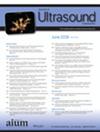The Influence of Probe Pressure on Appendix Visualization in Pediatric Sonography
Abstract
Objectives
To investigate the influence of ultrasound probe pressure on the visualization of the appendix sonographically.
Methods
Pediatric outpatients undergoing routine renal ultrasound (US) were approached for additional images using a standardized imaging protocol. The movement of the normal appendix (base and distal parts) was documented while applying probe pressure. The minimum pressure required for appendix identification and the maximum pressure required to elicit movement out of the field-of-view were recorded using a force sensor. Skin thickness was measured at baseline, at first appendix identification, and at maximal pressure. Appendiceal locations and peri-appendicular findings were also recorded.
Results
Forty-six US scans were included in the final analysis. The appendix was identified in all scans. Movement out of the field-of-view was documented in 30 scans, of which 12 showed movement of the entire appendix, 11 of the distal appendix, and seven of the appendicular base only. The mean pressure was lower when the appendix was identified than when its base and distal part moved out of the field-of-view. The mean skin thickness was comparable. Neither pressure nor skin thickness showed a statistically significant correlation with appendix movement out of the field-of-view.
Conclusions
Despite no statistically significant correlation between the applied pressure and the appendiceal movement, since all the appendices were identified with less pressure than the pressure needed to displace most of them out of the field-of-view, it is possible that the non-visualization of the appendix is attributed to the displacement of the organ due to excessive sonographic pressure.


 求助内容:
求助内容: 应助结果提醒方式:
应助结果提醒方式:


